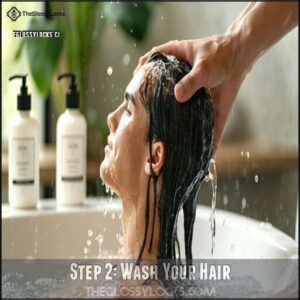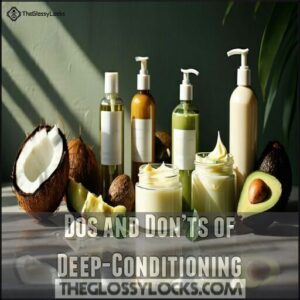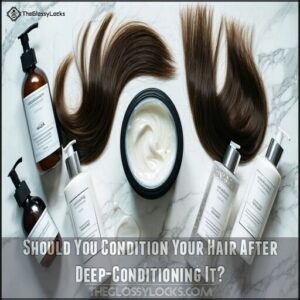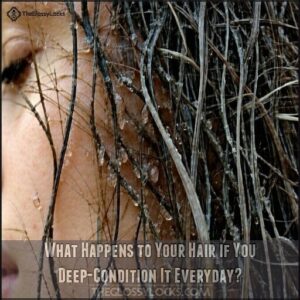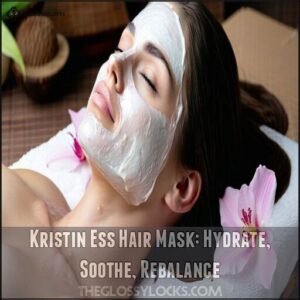This site is supported by our readers. We may earn a commission, at no cost to you, if you purchase through links.

You’ll need to apply it to clean, damp hair, focusing on ends where damage often strikes hardest.
Leave it on for 15-30 minutes—just enough time to catch up on your favorite show. For best results, wrap your hair in a warm towel to help the product penetrate each strand.
You can use store-bought masks or whip up something from your kitchen with ingredients like coconut oil or honey. Your hair’s transformation from straw-like to silky smooth might just make deep conditioning your new self-care ritual.
Table Of Contents
- Key Takeaways
- What is Deep-Conditioning?
- How to Deep-Condition Hair?
- Homemade Deep-Conditioners
- Benefits of a Deep-Conditioning Treatment
- Dos and Don’ts of Deep-Conditioning
- How Long Should You Leave Your Product on For?
- How Often Should You Deep-Condition Your Hair?
- Should You Condition Your Hair After Deep-Conditioning It?
- What Happens to Your Hair if You Deep-Condition It Everyday?
- Recommended Deep-Conditioning Treatments
- Frequently Asked Questions (FAQs)
- How does deep conditioning work?
- How to apply the deep conditioning treatment?
- How do you use a deep conditioner?
- How do you choose a deep conditioning product?
- How long does it take to deep condition hair?
- Can you use normal conditioner for deep conditioning?
- How many times do you deep condition your hair?
- Are deep conditioning treatments at salons worth it?
- How much is a deep conditioning treatment at a salon?
- What ingredients should I look for in a deep conditioner?
- Conclusion
Key Takeaways
- You’ll get the best results from deep conditioning by applying it to clean, damp hair and focusing on damaged ends, then leaving it on for 15-30 minutes with a warm towel wrap for better penetration.
- Your hair type determines how often you should deep condition – weekly treatments work for most hair types, but curly or damaged hair benefits from twice-weekly sessions while fine hair may only need it every 2-3 weeks.
- You can make effective homemade deep conditioners using kitchen ingredients like coconut oil, honey, bananas, olive oil, or eggs that hydrate and repair damaged strands.
- You’ll see multiple benefits from regular deep conditioning including increased hydration, reduced damage, improved shine, strengthened strands, and better color retention for treated hair.
What is Deep-Conditioning?
Deep conditioning is like a spa day for your hair—hydrating, repairing, and tackling dryness all at once.
A deep conditioning treatment uses rich ingredients like shea butter, keratin, or jojoba oil to target damage and replenish moisture.
Deep conditioning transforms your hair with luxurious ingredients that both repair damage and quench thirsty strands in one powerful treatment.
It’s perfect for any hair type, whether you’re aiming to revive dull strands or create a protective shield against breakage, offering hydration vs repair in one go.
Regular use guarantees shinier, smoother, more manageable locks every time, and for peak hair health, consider using both deep conditioners and hair masks together.
How to Deep-Condition Hair?
Deep-conditioning your hair sounds tricky, but it’s actually simple when you follow the right steps.
Start with a quality product, apply it correctly, and let it work its magic for healthier, stronger strands.
Step 1: Choose Your Product
When choosing the best deep conditioner, think about your hair type, scalp sensitivity, and ingredient benefits.
For dry hair, look for a moisturizing hair mask with shea butter or coconut oil.
Thinning or damaged hair thrives on proteins like keratin.
Need hydration? A hydrating hair treatment like Olaplex or Living Proof works wonders.
Many options exist if you condition extremely dry hair.
Pick products that suit your hair’s story!
Step 2: Wash Your Hair
Start by shampooing with a sulfate-free option to gently cleanse and remove product buildup.
Use warm water to open the cuticle and help your hair absorb the conditioner later. Massage your scalp with your fingertips—it’s like a mini spa moment that removes dirt and oil.
Rinse thoroughly, leaving no residue behind, for a clean slate before conditioning, which is a crucial step to ensure your hair is properly prepared for the next steps, making it ready for a clean slate.
Step 3: Apply Your Deep Conditioner
When applying your deep conditioning treatment, focus on even product distribution—your hair will thank you!
Start with clean, damp hair, and use a generous amount of hair conditioner, concentrating on the mid-lengths and ends where dryness often shows.
Avoid the scalp unless your hair care routine requires scalp application, particularly for treatments targeting hydration or damage repair.
Sectioning hair beforehand guarantees every strand gets maximum benefit; use a wide-tooth comb to spread the product evenly.
For extra impact, consider capping hair with a plastic shower cap to prevent drying out while enhancing absorption.
Stick to thick layers for tight curls or coarse textures, but go lighter for finer hair.
Rinse thoroughly with cool water after 20-30 minutes to seal moisture.
Step 4: Let The Conditioner Set In
Once your hair conditioning pack is applied, let it work its magic.
The ideal timing varies, but most suggest 10 to 30 minutes for full product penetration.
Try wrapping your hair with a towel or cap to lock in moisture.
Setting duration impacts deep conditioning benefits, so don’t rush this step in your deep conditioning routine.
Step 5: Use Heat if Required
Using heat during your deep conditioning treatment can boost your results.
Heat tools like hooded dryers or blow dryers help open your hair’s cuticles to absorb nutrients and moisture from hair masks.
Keep the heat gentle and don’t overdo it—10 to 30 minutes is enough.
Consider using a quality hooded dryer for even heat distribution.
Focus on the mid-lengths to ends for most hair types, as too much heat near the scalp might cause irritation or dryness, and remember to use gentle heat to avoid damage, and always consider the quality of your hair tools.
Homemade Deep-Conditioners
Making your own deep-conditioner can save you money and give your hair a natural boost.
With simple ingredients like honey, coconut oil, and eggs, you’ll treat dryness and restore shine in no time.
Honey and Coconut Oil
Honey and coconut oil make an amazing homemade hair mask for deep conditioning.
Honey’s benefits include locking in moisture and taming frizz, while coconut oil repairs damage with fatty acids, leaving hair shiny and soft.
Warm the coconut oil slightly, mix it with honey until smooth, and apply generously from roots to ends.
Let it sit for 30 minutes, then rinse thoroughly, and your hair will feel nourished and refreshed!
Banana Hair Mask
Feeling adventurous after trying honey and coconut oil? A banana hair mask is the perfect way to pamper your hair while tackling dryness.
Packed with nutrients, this natural hair mask hydrates strands, smooths split ends, and boosts shine.
To make it, mash a ripe banana with a tablespoon of olive oil or yogurt until smooth. Apply the mixture from mid-shaft to ends on clean, damp hair.
Leave for 20 minutes, rinse completely, and enjoy silky, soft locks!
Bananas contain essential silica ingredients that help combat frizzy hair.
Olive Oil and Egg Hair Mask
Eggs and olive oil are a dream team for natural hair care.
This DIY mask adds moisture, repairs damage, and tames frizz. Whisk one egg with two tablespoons of olive oil, then apply mid-length to ends on damp, clean hair. Leave on 20-30 minutes, rinse thoroughly, and avoid overuse to prevent protein overload.
- Benefits: Deep moisture, reduced breakage.
- Tips: Use extra virgin olive oil for purity.
- Concerns: Patch-test egg yolk if protein-sensitive.
- Application: Focus on split ends, avoid roots.
Benefits of a Deep-Conditioning Treatment
A deep-conditioning treatment works wonders by delivering intense hydration and nutrients to your hair, helping it look and feel its best.
Whether you’re tackling dryness, frizz, or damage, this simple step can transform your hair’s texture, shine, and strength.
Hydrates Your Hair
A deep conditioning treatment is your hair’s secret weapon for turning dryness into luscious softness.
With powerful ingredients like shea butter, coconut oil, and aloe vera, deep hair hydration penetrates each strand, locking in moisture and boosting scalp hydration.
If your hair craves more humidity, try adjusting your hydration frequency—tight curls often need deep conditioning weekly or more.
The real magic? Enhanced moisture retention that tames frizz and transforms your hair into manageable silk.
Whether you choose premium treatments or whip up homemade recipes, the focus stays on ingredient benefits for lasting hair moisture.
So, give your thirsty locks what they need.
It’s like giving water to a wilting plant—it’s miraculous!
Reduces Damage
Repairing your hair after years of heat damage and chemical treatments doesn’t have to be rocket science.
A deep conditioning treatment packed with proteins helps restore broken bonds and fights off split ends before they get worse.
- Boosts resilience with protein hair treatments.
- Helps prevent breakage by repairing hair structure.
- Fights frizz for sleek, smooth locks.
- Nourishes damaged hair for long-lasting softness.
For best results, use a heat-activated hair strengthening mask weekly!
Improves Shine
A good deep conditioning treatment isn’t just about hydration—it’s your ticket to a mirror-like finish.
By smoothing cuticles and enhancing light reflection, deep conditioners boost hair brightness and improve volume.
Glossy ingredients like shea butter or jojoba oil make a hair mask for shine a must-have.
Think of it as lamination for your strands.
| Key Benefit | Explanation |
|---|---|
| Glossy Ingredients | Boost hair shine with nourishing oils. |
| Reflective Properties | Smooth hair cuticles for better light bounce. |
| Shine Duration | Keeps hair looking radiant longer. |
| Hair Lamination | Creates a sleek, polished effect. |
| Hair Volume | Adds body while maintaining shine. |
Strengthens Your Hair
Stronger hair starts with a good deep conditioning treatment. By repairing hair bonds and improving elasticity, it minimizes hair breakage and boosts overall hair strength.
Protein treatments nourish healthy follicles, while damage repair ingredients dive deep into the strands.
Regular use transforms brittle hair into resilient locks, ensuring your mane stays smooth, shiny, and ready to handle life’s styling challenges with improved elasticity and hair strength.
Nourishes Colour-Treated Hair
Keeping your color-treated hair vibrant isn’t just about skipping harsh shampoos; it’s about giving it the TLC it craves with deep conditioning.
A deep conditioning treatment hydrates, strengthens, and locks in color longevity. Here’s how it helps:
- Boosts hydration needs to combat dryness.
- Protects against UV damage that fades color.
- Maintains protein balance to reduce breakage.
- Seals cuticles for hair color protection.
- Tones hair, reducing brassiness and enhancing softness.
Your hair deserves this love!
Dos and Don’ts of Deep-Conditioning
Getting the most out of deep-conditioning comes down to using the right techniques and avoiding common mistakes.
Follow these dos and don’ts to keep your hair healthy, shiny, and full of life.
DOs
Deep conditioning treatments can transform your hair if you know the DOs! First, focus on product selection. Find one suited to your hair type—for example, thick hair loves shea butter-rich masks, while lightweight options suit finer strands. Always start with clean hair to help the conditioner really absorb. A gentle shampoo works wonders to prep your locks.
Apply from mid-length to tips, ensuring even distribution—dry areas need the most love! For scalp coverage, it depends: avoid roots if you’ve got oily hair, or apply closer to roots for dryness.
Here’s a cheat sheet:
Step Technique Bonus Tips
Let it sit for 10-30 minutes, then rinse thoroughly.
DON’Ts
While deep conditioning benefits your hair, there are some don’ts to keep in mind for the best results.
First, don’t overdo it—over-conditioning can lead to product buildup, making your hair greasy instead of repaired. Over-processing is another mistake; leaving the treatment in too long can weigh your hair down or cause scalp neglect.
Remember that hair masks offer deeper nourishment compared to deep conditioners.
Here’s what to avoid:
- Ignoring ingredients: Steer clear of formulas packed with silicones or heavy oils if your hair is fine or oily.
- Wrong application: Focus on mid-lengths and ends, not the roots, to prevent a greasy scalp.
- Hot water rinsing: Always rinse with cool water to seal moisture and lock in the deep conditioning benefits.
Stick to these tips to keep hair damage at bay!
How Long Should You Leave Your Product on For?
Getting the most from a deep conditioning treatment means timing it right.
The optimal time is usually 20–30 minutes, letting ingredients fully hydrate and repair.
Need more impact? Heat application helps, but don’t overdo it to avoid over-conditioning risks like weakened strands.
Follow these deep conditioning tips:
- Always check your product’s label for guidance.
- Use heat sparingly to boost hydration.
- Focus on ends if you’ve got oily roots.
- Rinse with cool water for shiny, sealed strands.
- Experiment to suit your hair type.
How Often Should You Deep-Condition Your Hair?
Finding your ideal deep conditioning schedule depends largely on your hair type and damage level.
Weekly treatments work well for most people, but your unique needs might differ.
Consider these factors when deciding your routine:
- Curly or coily hair typically needs more frequent conditioning (weekly or bi-weekly) as it’s naturally drier.
- Color-treated or heat-damaged hair benefits from weekly deep conditioning to restore moisture.
- Fine, straight hair may only need deep conditioning every 2-3 weeks to avoid weighing it down.
Seasonal changes matter too—increase frequency during dry winter months and after summer sun exposure for best hair care results to achieve healthy hair.
Should You Condition Your Hair After Deep-Conditioning It?
The age-old question puzzles many: should you condition after a deep conditioning treatment? Truth is, it depends on your hair porosity and texture.
For fine or straight locks, skip the extra conditioner to avoid product buildup. However, if you have thick, textured, or heat-damaged hair, a lightweight conditioner helps seal in benefits and improves detangling.
Consider your hair’s treatment order carefully—some masks already contain enough emollients and humectants. Listen to your strands; increased frizz after washing indicates your double conditioning approach needs adjustment.
Remember, proper hair care isn’t one-size-fits-all! For severely damaged hair, consider that a deep conditioner should be used once every two months.
What Happens to Your Hair if You Deep-Condition It Everyday?
Why would daily deep conditioning harm your hair? Despite good intentions, conditioning your hair every day often leads to product buildup and compromises scalp health.
Like watering a plant too much, excessive moisture can actually damage your hair’s natural balance. Over-conditioning creates protein overload, where your strands become overly saturated with nutrients they can’t absorb.
This affects hair elasticity, making it feel oddly mushy or stretchy when wet—signs of hygral fatigue. The long-term effects can include limp, greasy strands that appear weighed down rather than healthy.
Your hair may paradoxically become more difficult to manage as it develops dependency on frequent treatments. For most hair types, deep conditioning once weekly provides ideal hair hydration without risking damage.
If you have extremely dry or damaged hair requiring hair repair, twice weekly might work, but daily treatments typically do more harm than good. Remember: sometimes less is more in the context of damaged hair repair, and it’s crucial to find the right balance to avoid damaging your hair.
Recommended Deep-Conditioning Treatments
You’ll find the perfect solution for your hair concerns among these carefully selected deep conditioning treatments that deliver professional-quality results at home.
From SheaMoisture’s Intensive Hydration Hair Mask for extreme moisture to Olaplex’s bond-repairing formulas, these products will transform your damaged strands into healthier, more manageable hair.
Kristin Ess Hair Mask: Hydrate, Soothe, Rebalance
This botanical powerhouse transforms dry, irritated locks into silky, balanced strands.
It’s a botanical powerhouse that delivers essential moisture through its whipped texture, featuring natural minerals and botanical oils that calm your scalp while smoothing damaged cuticles.
The vegan, cruelty-free formula protects color-treated hair while reducing frizz for a polished look.
It’s lightweight enough for frequent use without weighing down your roots.
You can find various related products online.
Apply it to damp hair for a deeply hydrating experience that leaves your mane noticeably softer after just one use, with a formula that is also cruelty-free.
Strengthen Hair Length, Proteins, All Types
While Kristin Ess soothes your scalp, protein treatments tackle a different challenge – strengthening your hair’s structure.
Protein-rich conditioners restore elasticity and prevent damage where you need it most. They’re your secret weapon against breakage, helping with length retention without causing protein overload.
The right formula works for all hair types, delivering nutrients exactly where needed. For best results, apply with heat for 15-20 minutes to see vibrant, frizz-free hair that’s visibly healthier.
Olaplex Hair Perfector No3
While protein treatments strengthen hair externally, Olaplex Hair Perfector No3 works its magic from within. This revolutionary at-home hair repair treatment rebuilds broken disulfide bonds at the molecular level, addressing damage where it truly begins.
When using this deep conditioning treatment, you’ll notice:
- Hair becomes 3X stronger after just one application
- Works for all hair types and damage levels
- Results are visible immediately, with continued improvement over time
- The bond repair mechanism protects against future damage
For authentic Olaplex results, apply to damp hair weekly, leave on for at least 10 minutes, then rinse and style as usual. This will help you achieve the best possible hair repair with Olaplex Hair Perfector No3, leading to visible improvement and long-lasting benefits.
Frequently Asked Questions (FAQs)
How does deep conditioning work?
Deep conditioning works by allowing nutrient-rich moisturizers to penetrate your hair shaft.
You’ll lock in hydration and repair damage when these formulas coat your strands, filling gaps in the cuticle and restoring elasticity.
How to apply the deep conditioning treatment?
Apply to damp hair after shampooing, focusing on mid-lengths to ends.
Cover with a shower cap for 10-30 minutes, then rinse thoroughly with cool water.
Heat can enhance absorption for better results.
How do you use a deep conditioner?
After shampooing, apply the conditioner to damp hair from mid-shaft to ends. Leave it on for 10-30 minutes, optionally using heat or a shower cap. Rinse thoroughly with cool water.
How do you choose a deep conditioning product?
Wondering what’s best for your locks?
Consider your hair type, specific concerns like damage or dryness, and key ingredients.
Look for products with moisturizers like shea butter for dry hair or proteins for strengthening.
How long does it take to deep condition hair?
You’ll typically need 10-30 minutes for effective deep conditioning.
Most products require at least 5 minutes, but leaving treatments on for 15-20 minutes often yields better results.
Heat can enhance penetration during this time.
Can you use normal conditioner for deep conditioning?
While you can use regular conditioner in a pinch, it’s not formulated for deep treatment.
Regular conditioners don’t have the concentrated ingredients or thick consistency needed for truly effective deep conditioning results.
How many times do you deep condition your hair?
You should deep condition your hair once or twice weekly.
By jove, hair type matters!
For extremely dry or damaged hair, two sessions weekly works best.
For normal hair, once weekly is sufficient.
Are deep conditioning treatments at salons worth it?
Professional salon treatments can be worth it for intensive restoration and personalized care.
You’ll get premium ingredients and expert application techniques that aren’t always achievable at home, particularly for severely damaged hair.
How much is a deep conditioning treatment at a salon?
Salon prices range from $25 to $75 for your intensive hair therapy.
You’ll pay more at high-end establishments and less at budget salons.
Add-on treatments often cost $15-30 when paired with a haircut, which can be considered an intensive hair therapy.
What ingredients should I look for in a deep conditioner?
Wondering what your deep conditioner should contain?
Look for moisturizing oils (coconut, avocado, jojoba), strengthening proteins (keratin, amino acids), humectants like honey, and nourishing ingredients like shea butter and aloe vera.
Conclusion
While deep conditioning treatments might seem like an extra step in your routine, they’re truly worth the time investment.
Whether you choose store-bought masks or DIY recipes, incorporating a deep conditioning treatment into your hair care regimen will transform damaged locks into healthy, vibrant strands.
Your hair deserves this special attention—just 15-30 minutes weekly can repair years of damage.
So grab your favorite product, set a timer, and get ready to enjoy the silky, manageable results you’ve been craving, with a hair care regimen that truly works.
- https://www.johnfrieda.com/en-uk/blog/hair-care/how-to-deep-condition-hair/
- https://www.healthline.com/health/beauty-skin-care/how-to-deep-condition-hair
- https://www.nexxus.com/us/en/haircare-101/what-is-deep-conditioning.html
- https://www.cosmopolitan.com/style-beauty/beauty/g28313157/best-deep-conditioner/
- https://lomabeauty.us/products/deep-conditioner?srsltid=AfmBOoooTCSdIgemKOaTk78rpq24Z3JWjWEzWj0nQKUwtqVGr8b-ZIio



